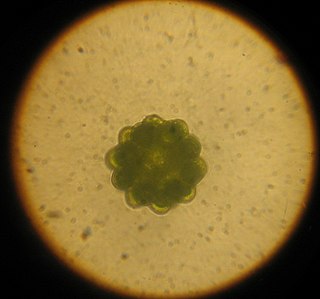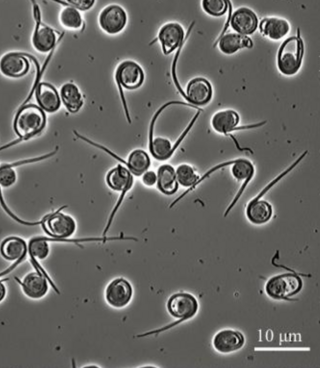
Chlorophyta is a taxon of green algae informally called chlorophytes. The name is used in two very different senses, so care is needed to determine the use by a particular author. In older classification systems, it is a highly paraphyletic group of all the green algae within the green plants (Viridiplantae) and thus includes about 7,000 species of mostly aquatic photosynthetic eukaryotic organisms. In newer classifications, it is the sister clade of the streptophytes/charophytes. The clade Streptophyta consists of the Charophyta in which the Embryophyta emerged. In this latter sense the Chlorophyta includes only about 4,300 species. About 90% of all known species live in freshwater. Like the land plants, green algae contain chlorophyll a and chlorophyll b and store food as starch in their plastids.

The green algae are a group consisting of the Prasinodermophyta and its unnamed sister which contains the Chlorophyta and Charophyta/Streptophyta. The land plants (Embryophytes) have emerged deep in the Charophyte alga as sister of the Zygnematophyceae. Since the realization that the Embryophytes emerged within the green algae, some authors are starting to include them. The completed clade that includes both green algae and embryophytes is monophyletic and is referred to as the clade Viridiplantae and as the kingdom Plantae. The green algae include unicellular and colonial flagellates, most with two flagella per cell, as well as various colonial, coccoid and filamentous forms, and macroscopic, multicellular seaweeds. There are about 22,000 species of green algae. Many species live most of their lives as single cells, while other species form coenobia (colonies), long filaments, or highly differentiated macroscopic seaweeds.

Charophyta is a group of freshwater green algae, called charophytes, sometimes treated as a division, yet also as a superdivision or an unranked clade. The terrestrial plants, the Embryophyta emerged deep within Charophyta, possibly from terrestrial unicellular charophytes, with the class Zygnematophyceae as a sister group.

Sphaeropleales is an order of green algae that used to be called Chlorococcales. The order includes some of the most common freshwater planktonic algae such as Scenedesmus and Pediastrum. The Spaeropleales includes vegetatively non-motile unicellular or colonial taxa that have biflagellate zoospores with flagella that are directly opposed in direction : Sphaeroplea, Atractomorpha, Neochloris, Hydrodictyon, and Pediastrum. All of these taxa have basal body core connections.

Viridiplantae constitute a clade of eukaryotic organisms that comprises approximately 450,000–500,000 species that play important roles in both terrestrial and aquatic ecosystems. They include the green algae, which are primarily aquatic, and the land plants (embryophytes), which emerged from within them. Green algae traditionally excludes the land plants, rendering them a paraphyletic group. However it is accurate to think of land plants as a kind of alga. Since the realization that the embryophytes emerged from within the green algae, some authors are starting to include them. They have cells with cellulose in their cell walls, and primary chloroplasts derived from endosymbiosis with cyanobacteria that contain chlorophylls a and b and lack phycobilins. Corroborating this, a basal phagotroph archaeplastida group has been found in the Rhodelphydia.

Tetradesmus dimorphus is a freshwater unicellular green algae in the class Chlorophyceae. The name means "having two forms".
Chlorococcales is a formerly recognized order of green algae in the class Chlorophyceae. As of February 2022, the type family Chlorococcaceae was placed in the order Chlamydomonadales.

Scenedesmus acuminatus is a green alga in the family Scenedesmaceae.

Coelastrum is a genus of green algae in the Scenedesmaceae family.

The prasinophytes are a group of unicellular green algae. Prasinophytes mainly include marine planktonic species, as well as some freshwater representatives. The prasinophytes are morphologically diverse, including flagellates with one to eight flagella and non-motile (coccoid) unicells. The cells of many species are covered with organic body scales; others are naked. Well studied genera include Ostreococcus, considered to be the smallest free-living eukaryote, and Micromonas, both of which are found in marine waters worldwide. Prasinophytes have simple cellular structures, containing a single chloroplast and a single mitochondrion. The genomes are relatively small compared to other eukaryotes . At least one species, the Antarctic form Pyramimonas gelidicola, is capable of phagocytosis and is therefore a mixotrophic algae.

The Trebouxiophyceae are a class of green algae, in the division Chlorophyta. Their circumscription within the green algae is not well established due to the need for more genetic studies at higher levels within the group.

Chlorodendrales are an order of green, flagellated, thecate, unicellular eukaryotes, within the green algae class Chlorodendrophyceae. Prasinophyceae are defined by their cellular scales which are composed of carbohydrates, and Chlorodendrales are unique within this group due to these scales forming a fused thecal wall. Cells of Chlorodendrales are completely covered in scales, which fuse around the cell body producing the theca, but remain individually separated on the flagella, of which there are typically four per cell. Species within Chlorodendrales live in both marine and fresh water habitats, occupying both benthic and planktonic food webs. Additionally, they are photoautotrophs, meaning they produce their own food through the conversion of sunlight into chemical energy.
Pedinomonadaceae is a family of green algae. They are small single-celled algae. Each cell has a single flagellum. Molecular data has provided evidence for an independent class Pedinophyceae, sister to all phycoplast-containing core Chlorophyta.

Selenastraceae is a family of green algae in the order Sphaeropleales. Members of this family are common components of the phytoplankton in freshwater habitats worldwide. A few species have been found in brackish and marine habitats, such as in the Baltic Sea.

Udoteaceae is a family of green algae, in the order Bryopsidales.

Helicosporidium is a genus of colorless, pathogenic algae in the class Trebouxiophyceae of the green algae. It is a parasite found in the gut of insects, and a close relative of Prototheca.

Tetradesmus is a genus of green algae in the family Scenedesmaceae.

The Klebsormidiaceae are a family containing five genera of charophyte green alga forming multicellular, non-branching filaments. The genus Chlorokybus was previously included as well, but this problematic and poorly known genus is now placed in a separate class Chlorokybophyceae.

The marine Prasinodermophyta are a proposed basal Viridiplantae clade, as sister of another clade comprising the Chlorophyta and the Streptophyta. It consists of the Prasinodermophyceae and the Palmophyllophyceae. They were previously considered to be a basal Chlorophyta clade, or part of the "Prasinophytes".



















